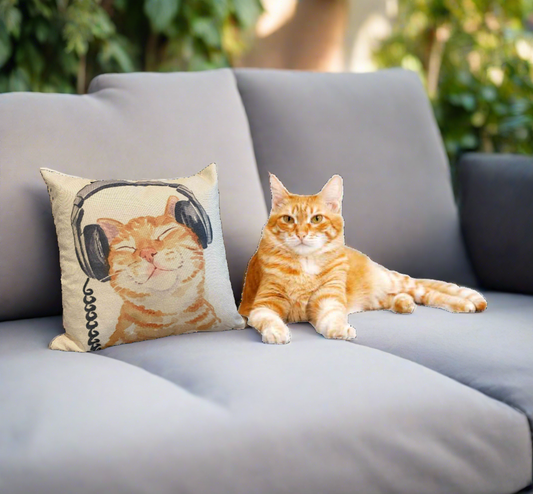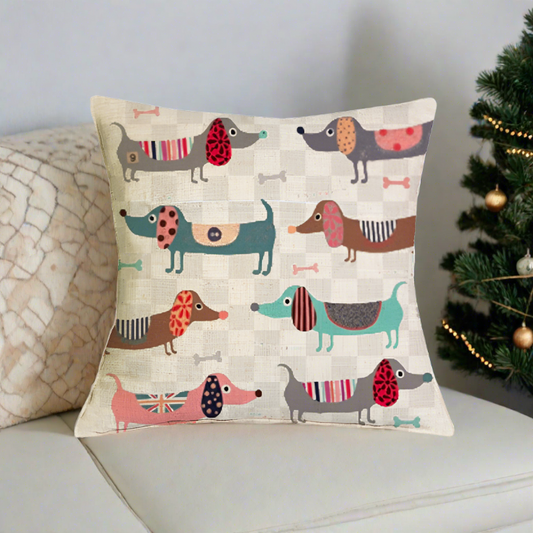What is a Standard Pillow?
A standard pillow measures 20 x 26 inches. This size makes it manageable and easy to fit into most pillowcases. You likely encounter this pillow size in many homes because of its convenience and adaptability to various sleeping positions.
Standard pillows come in various materials. Common materials include down, memory foam, and synthetic fibers. Down pillows provide a soft, luxurious feel, while memory foam offers support by contouring to your head and neck. Synthetic fibers, often hypoallergenic, cater to those with allergies and offer a good balance of comfort and support.
Versatility is a key feature of standard pillows. They are widely used in households for sleeping, providing comfort whether you sleep on your back, side, or stomach. They also serve multiple purposes, such as supporting your back while sitting up in bed or acting as decorative accents on your couch.
The typical lifespan of a standard pillow varies with the material. Down pillows usually last about 5-10 years, whereas memory foam pillows have a lifespan of about 2-3 years. Synthetic fiber pillows generally need replacing every 1-2 years. Regular maintenance, like fluffing and washing pillow shams, helps extend their lifespan. Using pillow protectors also adds an extra layer of protection against dust and allergens.

How to Select the Right Standard Pillow
Choosing the right standard pillow involves several key factors. Understanding these will help you make a better decision for your specific needs.
1. Firmness: The firmness of a pillow affects your comfort and support. Pillows range from soft to firm.
- Soft pillows: Ideal for stomach sleepers as they provide minimal lift, keeping the neck in a neutral position.
- Medium pillows: Best for back sleepers, offering a balance of support and comfort.
- Firm pillows: Perfect for side sleepers, ensuring the head and neck remain aligned with the spine.
2. Fill Material: The fill material determines a pillow’s feel and support.
- Down: Offers a plush, luxurious feel.
- Memory Foam: Provides excellent support by contouring to your head and neck.
- Synthetic Fibers: Hypoallergenic and often more affordable, these pillows offer moderate support and are easy to maintain.
3. Sleeping Position: Your sleeping position influences the type of pillow you should choose.
- Back Sleepers: Opt for medium-firm pillows to maintain neck alignment.
- Side Sleepers: Need firm pillows to fill the gap between the neck and the mattress. Learn more about best pillows for side sleepers.
- Stomach Sleepers: Prefer soft pillows to avoid straining the neck.
4. Testing Pillow Comfort and Support: Before purchasing, it’s essential to test the pillow’s comfort and support.
- In-Store Testing: Lay your head on the pillow for a few minutes in your usual sleeping position.
- Return Policies: Check if the store offers a trial period or return policy to ensure you can test the pillow at home.
5. Hypoallergenic Options: For allergy sufferers, hypoallergenic pillows are crucial.
- Materials: Look for pillows filled with synthetic fibers or special hypoallergenic down alternatives.
- Covers: Use pillow protectors designed to block allergens such as dust mites and pet dander.
6. Adjustable Fill Pillows: Adjustable fill pillows offer personalized comfort by allowing you to modify the amount of fill.
- Customization: Add or remove fill to achieve your desired firmness and loft.
- Versatility: Suitable for all sleeping positions since you can adjust to meet specific needs.
Selecting the right standard pillow involves considering firmness, fill material, and your sleeping position. Testing the pillow, choosing hypoallergenic options if needed, and considering adjustable fill pillows can lead to a more comfortable and personalized sleeping experience.

Different Uses of Standard Pillows
Standard pillows are versatile and serve various functions beyond just sleeping. Understanding these uses can help you maximize their benefits.
1. Sleeping in Bed: The most common use for standard pillows is for sleeping.
- Head and Neck Support: Standard pillows (20 x 26 inches) provide essential support for your head and neck, ensuring you maintain proper spinal alignment.
- Sleep Quality: Using the right pillow can improve sleep quality by reducing discomfort and preventing neck pain.
2. Lumbar Support While Sitting: Standard pillows can also be repurposed for lumbar support.
- Office Chairs: Place a standard pillow behind your lower back while sitting at your desk to maintain the natural curve of your spine.
- Couches and Armchairs: Using pillows as lumbar support can make prolonged sitting more comfortable and reduce back strain.
3. Decorative Settings: Standard pillows add a touch of style to your home decor.
- Couch Accents: Use colorful or patterned pillowcases to match your living room theme. A couple of well-placed pillows can make a couch look inviting and cozy.
- Chair Accents: Adding a pillow to a chair can enhance its visual appeal and provide additional comfort for guests.
4. Travel Support: Standard pillows are handy for travel, providing comfort in various situations.
- Neck Support: While on long flights or car rides, a standard pillow can be folded or rolled to support your neck, reducing strain.
- Back Support: Placing a pillow behind your back while seated on long journeys can alleviate discomfort and make travel more pleasant.
Standard pillows serve multiple purposes, from enhancing sleep quality to adding style to your home and providing support during travel. Understanding these various uses allows you to make the most of a standard pillow in different settings.
What are the Alternatives to Standard Pillows?
Queen Size Pillows
Dimensions and Best Users:
- Dimensions: Queen size pillows measure 20 x 30 inches, offering more length than standard pillows.
- Who They Are Best For: Ideal for restless sleepers who shift positions frequently; the additional length ensures your head remains supported throughout the night.
Compatibility with Larger Beds:
- Larger Beds: Perfect for queen beds—two queen pillows fit snugly across a queen mattress.
- Versatility: Also suitable for full beds and twin beds for those desiring extra pillow length.
King Size Pillows
Dimensions and Added Support:
- Dimensions: King size pillows measure 20 x 36 inches, providing the most length among common pillow sizes.
- Added Support: The extra length offers enhanced support for your head, neck, and shoulders, making it a good choice for taller individuals.
Suitability for Active Sleepers:
- Active Sleepers: Ideal for those who move around a lot during sleep; ensures continuous support regardless of position.
- Bed Compatibility: Best suited for king and California king beds—two king pillows cover the entire width of a king-size mattress.
Specialty Pillows
Types and Specific Benefits:
-
Cervical Pillows:
- Design: Contoured to support the neck's natural curve.
- Use Case: Beneficial for those suffering from neck pain or stiffness; helps maintain proper alignment during sleep.
-
Body Pillows:
- Dimensions: Typically 20 x 54 inches.
- Use Case: Provide full-body support; great for side sleepers, pregnant women, and those with back pain.
- Benefits: Helps align the spine, reduces pressure on the hips and shoulders, and offers a hugging sensation for comfort.
-
Orthopedic Pillows:
- Design: Specifically shaped to support various body parts.
- Use Case: Often used for medical purposes such as post-surgery recovery or chronic pain management.
- Benefits: Can target specific areas like the lower back, knees, or cervical region, providing tailored support and relief.
Alternative pillow options offer unique benefits and are designed to meet specific needs, from accommodating different sleep styles to providing specialized support for medical conditions. Understanding these alternatives helps you choose the right pillow for optimal comfort and health.
See a complete guide of pillow insert size chart.
How to Care for Your Standard Pillow
Regular Cleaning and Maintenance
Steps for Cleaning:
- Check the Label: Always start by reading the care label on your pillow. It provides specific cleaning instructions.
- Machine Wash: Most pillows, especially those filled with synthetic fibers, can be washed in a machine. Use a mild detergent and select a gentle cycle.
- Drying: Dry pillows completely to prevent mildew. Use a low heat setting. Toss in a couple of tennis balls wrapped in socks to keep the filling evenly distributed.
Learn more about how to wash and clean your pillow.
Maintenance Tips:
- Fluff Daily: Fluff your pillow daily to maintain its shape and support.
- Air Out: Once a month, air out your pillow by placing it outside in the sun. This helps eliminate odors and bacteria.
Importance of Pillow Protectors
Benefits of Using Protectors:
- Barrier Against Allergens: Pillow protectors act as a barrier against dust mites, pet dander, and other allergens.
- Extend Pillow Life: They keep your pillow cleaner by preventing sweat and oils from penetrating the pillow fill.
- Easy to Clean: Protectors are easier to wash regularly compared to the entire pillow.
Proper Storage When Not in Use
Storing Pillows Correctly:
- Clean First: Always wash and thoroughly dry your pillow before storing to prevent mildew.
- Use Breathable Bags: Store pillows in breathable cotton bags, not plastic, to avoid trapping moisture.
- Keep in a Dry Place: Ensure the storage area is dry and free from direct sunlight to prevent yellowing and mold growth.
Signs It’s Time to Replace Your Pillow
Recognizing When to Replace:
- Loss of Shape: If your pillow doesn't spring back to its original shape after folding it in half, it’s losing its support.
- Lumps and Bumps: Feeling lumps or flattening spots indicates the filling has lost its integrity.
- Discoloration and Odor: Persistent yellow stains or unpleasant odors are signs of age and bacteria build-up.
- Allergy Symptoms: Increased allergy symptoms like sneezing or a runny nose could mean your pillow is harboring allergens.
By following these care tips, your standard pillow will remain comfortable and supportive for a longer period. Regular cleaning, using protectors, proper storage, and recognizing signs for replacement are key to pillow longevity and your overall sleep quality.
Common Questions About Standard Pillows
What is the Difference Between Standard and Queen Pillows?
Standard Pillows:
- Dimensions: 20 x 26 inches.
- Best For: Twin and full beds; single sleepers who don’t move around much during sleep.
- Versatility: Fits most standard pillowcases and can be easily found in stores.
Queen Pillows:
- Dimensions: 20 x 30 inches.
- Best For: Queen beds; people who toss and turn at night, offering extra length for better support.
- Compatibility: Fits snugly in standard pillowcases but may require specific queen pillowcases for a looser fit.
How Often Should You Replace a Standard Pillow?
Replacement Timeline:
- General Rule: Every 1 to 2 years.
-
Factors to Consider:
- Material: Down and memory foam pillows may last longer than synthetic fiber pillows.
- Usage: Pillows used nightly wear out faster than those used occasionally.
- Care: Regular cleaning and use of pillow protectors can extend the lifespan.
Can Standard Pillows Help with Specific Health Issues Like Neck Pain?
Health Benefits:
- Support: A good standard pillow provides adequate support to keep your head and neck aligned with your spine.
-
Material Choice:
- Memory Foam: Conforms to the shape of your head and neck, offering personalized support.
- Cervical Pillows: Specifically designed to support the natural curve of your neck, reducing pain and stiffness.
Usage Tips:
- Sleeping Position: Choose a pillow that supports your preferred sleeping position (side, back, or stomach).
- Firmness Level: Ensure the pillow’s firmness matches your comfort needs to prevent neck strain.
What are the Best Pillowcases for Standard Pillows?
Material Options:
- Cotton: Highly breathable and soft; ideal for most sleepers.
- Silk: Hypoallergenic and smooth; reduces friction on hair and skin.
- Bamboo: Naturally antimicrobial and moisture-wicking; great for hot sleepers.
Features to Look For:
- Thread Count: Higher thread counts (300-500) offer a softer, more durable fabric.
- Closure Type: Envelope closures or zippers keep the pillow securely inside the case.
- Size Fit: Ensure the pillowcase fits snugly to prevent the pillow from shifting or bunching up.
Recommendations:
- Hypoallergenic Pillowcases: Ideal for allergy sufferers to keep dust mites and allergens at bay.
- Cooling Pillowcases: Made from materials like moisture-wicking bamboo or cooling gel fibers for hot sleepers.
Understanding these aspects of standard pillows can help you choose the best options for your needs and improve your overall sleep quality.


















































